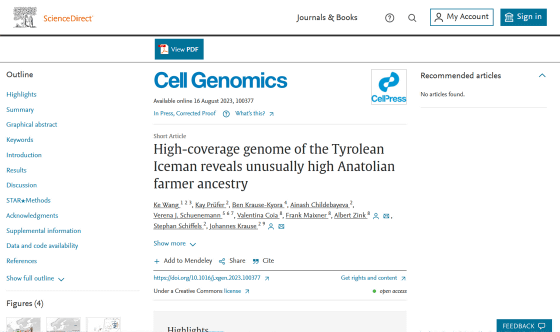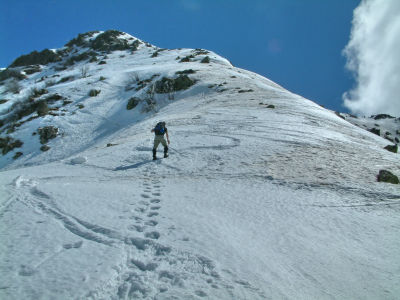The latest DNA analysis reveals that the ancient ``Iceman'' found in the Alps glacier was not European white, but West Asian and dark skin color

A male mummy ``
High-coverage genome of the Tyrolean Iceman reveals unusually high Anatolian farmer anancestry: Cell Genomics
https://doi.org/10.1016/j.xgen.2023.100377

Reanalysis of Iceman Ötzi's genome reveals da | EurekAlert!
https://www.eurekalert.org/news-releases/998276
The Famous 'Iceman' Ötzi Is Not Who We Thought He Was : ScienceAlert
https://www.sciencealert.com/the-famous-iceman-tzi-is-not-who-we-thought-he-was
Ötzi the Iceman may have been bald and getting fat before his murder 5,300 years ago | Live Science
https://www.livescience.com/archaeology/otzi-the-iceman-may-have-been-bald-and-getting-fat-before-his-murder-5300-years-ago
Iceman is a mummy discovered on the Italian side of the Alps in 1991, and was found to be a body around 3350 to 3120 BC by radiocarbon dating, etc., and the age at the time of death was around 46 years old. , It is also known that the cause of death was blood loss due to being attacked by someone. You can see what the mummified Iceman looks like by reading the following article.
'Iceman photoscan' where you can see the male mummy 'Iceman' found in the glacier carefully - GIGAZINE

Such an iceman was found in Italy, and has long been described as a ``blonde and long-haired white''. A 2012 study analyzing the Iceman's DNA also suggested that it was closely related to the Sardinians , with roots on the island of Sardinia in Italy, suggesting that the Iceman was a hybrid of eastern hunter-gatherers and white hunter-gatherers. presumed to be descendants.
However, as of 2012, there was a lack of genomic data on Europeans from 3000 to 4000 BC, who are the same age as Iceman. Recent studies have shown that genetic similarities in Icemans and modern Sardinians are common genetic elements that spread throughout Europe during the Neolithic period. It has also been shown that the 2012 genomic data was contaminated with modern human DNA, which is insufficient to draw accurate conclusions.
Therefore, a research team led by the Max Planck Institute for Evolutionary Anthropology in Germany collected DNA from the same part of the pelvis as the 2012 study and conducted DNA analysis using the latest genome sequencing technology.

Analysis revealed that the Iceman had an unusually high level of inherited Anatolian peasant genetics when compared to contemporary European populations. According to the research team, more than 92% of Iceman's ancestors had roots in Neolithic Anatolian farmers, and genetic exchange with European hunter-gatherers was not so advanced.
The findings suggest that the Iceman ancestors remained largely isolated from other European hunter-gatherers after their migration from Anatolia to Europe. For this reason, it has been pointed out that the Alps may have become a barrier to exchange.
It was also found that Iceman had genetic factors that cause higher levels of skin pigmentation than modern Europeans, as well as genes associated with diabetes, obesity, and male pattern baldness. These elements overturn the traditional image of Iceman as a white man with blond hair.

by Nikky
Related Posts:
in Science, Posted by log1h_ik







